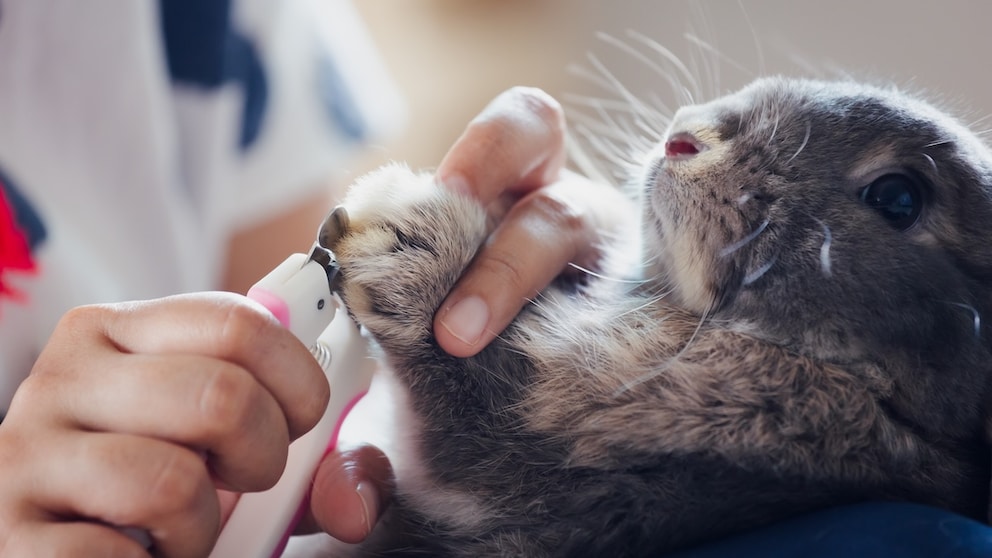October 17, 2024, 2:35 pm | Read time: 4 minutes
If a rabbit doesn’t wear down its claws sufficiently, owners often have to help. PETBOOK reveals what you should look out for.
A rabbit’s claws grow constantly, similar to human fingernails. By running on different surfaces or digging in the ground in the wild, rabbits’ claws usually wear out sufficiently on their own and do not cause any problems. Animals kept privately usually have fewer opportunities to wear down their claws. As a result, owners often have to trim their rabbit’s claws themselves.
When should you trim your rabbit’s claws?
If your rabbit’s claws do not wear off sufficiently on their own and, therefore, become too long, they should be trimmed. Rabbit claws that are too long can be recognized by the fact that they clatter when walking across the floor. However, the owner must take action no later than when the claws start to twist backward.
How often should you trim your rabbit’s claws?
This depends on the individual animal. For some rabbits, it is necessary every two weeks; for others, only every few months. In order not to miss the right time, you should, therefore, check your rabbit’s claws regularly.
How to trim your rabbit’s claws correctly
Trimming a rabbit’s nails properly requires the right equipment, patience, calm, and the right approach.
The right accessories
Specialized claw clippers designed for small animals are essential for safely trimming a rabbit’s claws. Ordinary nail scissors, household scissors, or nail clippers are not suitable. With household scissors, the claws can splinter, which is painful for the rabbit. The hind claws are often too thick for simple nail clippers. It is, therefore, better to use suitable accessories. Additionally, it’s important to have animal wound spray and, if necessary, sterile wound compresses readily available.
Proceed with caution
As claw trimming is very stressful for many rabbits, you should definitely take your time and proceed calmly. Ideally, you should get your pet used to this procedure from an early age. If you notice that the rabbit is experiencing extreme stress, you should proceed slowly and not cut all the claws at once. It is better to cut only one or two claws per day.
The correct procedure
It is easiest to trim the rabbit’s claws in pairs. One person can hold the rabbit on their lap while the other trims the claws. When you hold the rabbit on your lap, you should press the animal’s back against your own stomach and hold it firmly. Gently stroking the rabbit can help soothe and calm it during the process.
When cutting the claws, it is particularly important not to cut off too much of the claw. Blood vessels and nerves in each claw should not be damaged.
With light-colored claws, it is usually easy to see how much of the claw can be removed without damaging blood vessels or nerves. The claw clippers should be positioned a short distance behind the visible blood vessels to avoid injury. With dark claws, it is often more difficult to find the right point to shorten the claw. Illuminating darker claws with a powerful flashlight can aid in locating the blood vessels for a safer trim.
The following applies to the correct claw length: always leave the claws a little longer than the fur at this point. If you are still unsure, it is better to leave the claws a little longer than to cut them too short and injure blood vessels or even nerves.
What to do if injuries occur?
If you accidentally cut too deeply and the rabbit begins to bleed, remain calm and take immediate action. Press lightly on the claw with a sterile wound compress until the bleeding stops. Then, disinfect the wound. You should keep an eye on the injury over the next few days. If the wound starts bleeding again or becomes inflamed, or if the rabbit adopts an atypical posture, it is important to consult a vet.

Avoid injuries and stress Expert gives tips on how to cut birds’ claws correctly

Paw care Should you cut your cat’s claws?

An underestimated danger The cat has bitten! What to do now
Claw trimming is also possible at the vet
If you notice that your rabbit is squirming too much in your lap and is difficult to hold, or if you don’t feel confident trimming its claws yourself, it’s better not to do it. The risk of injury to your rabbit is then too high.
You can also have your rabbit’s claws trimmed by a vet. This typically costs between five and ten euros. If you are too unsure yourself, you can also have the vet show you how to do it properly so that you can do it yourself next time.

